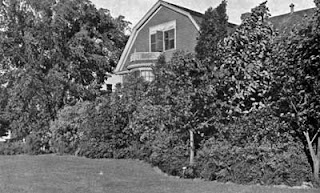 |
| 19th c. home of George W. Cable, The Amateur Garden |
During the late 19th century, suburban builders planted landscape plants around homes to highlight the grandeur of the property. Frederick Law Olmstead, founder of American landscapes, advised to ‘take care of the corners, and the centers will take care of themselves.’ Installing opulent shrubs and trees around foundations not only accented homes but created the framework to showcase the architecture of a new century.
 |
| Side view of George W. Cable's home in 1914 |
After World War II, houses became less expensive and landscape packages adjusted to budgets of veteran first-time home buyers. The next generation — baby-boomers— jumped into the middle class. The housing boom continued with smaller yards, less money for landscape budgets becoming the norm. Today with savvy builders and 21st century science of water and energy conservation leads the way in offering ‘green’ landscapes with their showcase homes. But for others, the Victorian trend of installing foundation plants continues with the 20th century artificial reality of zero-lot lines and instant landscapes. You can easily tell the age of an instant landscaped community by the large trees, scantily grassed front yards from the lack of sunlight, and overgrown shrubs blocking the view of the doors and windows. Its five to ten years old.
 |
| Example of instant landscaping after one year. |
Instant landscapes have a formula: Pack as many colorful plants around the house as possible to give that WOW factor so you can sell the house quickly. The buyers move in, loving the landscape, not realizing the costs and work ahead with high maintenance of pruning, pest control, and replacing stressed plants within a few years.
The first six months is the honeymoon, landscapes look good. But Olmstead’s advice that the centers will take care of themselves is a lie. Over the next two – three years though, the established landscapes mature and grow into their full size, requiring continual pruning to get to the door, or see out windows, or keep the trees from hitting the roof. Mold and mildew become issues with the moisture of irrigation hitting the home and lack of air circulation from the shrubs. With bi-weekly or monthly pruning necessary to prevent shrubs and trees from taking over the home, the shrubs succumb to die-back or ‘bare-bottom syndrome’, leaving the shrub looking forlorn and sickly.
 |
| Bare-bottom syndrome with die-back issues. |
How do you prevent instant landscapes?
- Use landscape plantings that allow for mature growth. Take the full width of a plant and divide it by half. If a tree grows 30 feet wide, plant it at
least 20 feet away from house or overhead wires. Hedge shrubs that will reach 6 feet wide
within two years, plant three feet apart.
- Do not cram perennials and ornamental shrubs together for the instant look. Instead, plant more perennials and ornamentals appropriately, and then use seasonal annuals, containers, and hanging baskets to provide more color.
- Pruning foundation plants should not be necessary. We shouldn’t put plants in to cut them unless it’s a formal landscape, a standard specimen, or a formal topiary. If a window ledge is three feet up from the ground, then use a shrub that will only grow to three feet or grow very slowly, so that pruning is an annual landscape chore.
- Install foundation plants at least two feet away from the foundation or outside of the roof line. This will allow the foundation plants to receive rainfall, and therefore cut supplemental irrigation, but also keep the soil at the foundation dry. Keeping the rootball moisture away around the home will also maintain the integrity of termiticide barrier, reducing susceptibility to termites.
- Shrubs should have three to four inches of mulch on top of the root ball, leaving the trunk flare visible but only use one to two inches of mulch around the foundation of the home. This will allow the moisture to dry around the house, again providing more termite protection.
How do you know how big a shrub or tree will get? A great landscape database to help determine appropriate size of shrubs and trees is the St Johns WaterManagement District’s Waterwise Landscapes website.
 |
| Correct landscape installation 2008 |
 |
| Same landscape 3 years later. |
Green builders want to provide better landscapes that will look great upon installation, are fabulous a year later, and within five years, look natural as if it had always been there. Green landscapes mean lower upfront landscape budget costs for the builder, getting more bang for your buck while selling the benefits of less maintenance, lower water bills, for the home buyer, resulting in a quicker home sale!
My label for shrubs that have no foliage at their base due to being pruned incorrectly.
Teresa Watkins, horticulturist, landscape designer, and environmental consultant is a Florida Water Star certifier, and a member of the USGBC-LEED Technical Advisory Group. Watkins is also host of the award-winning gardening radio show “In Your Backyard” heard on www.My790am.com every Tuesday at 1:00pm. You can contact or send questions to Teresa at www.she-consulting.com.






No comments:
Post a Comment